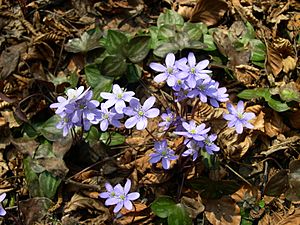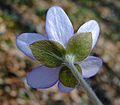Anemone hepatica facts for kids
Quick facts for kids Anemone hepatica |
|
|---|---|
 |
|
| Scientific classification | |
| Genus: |
Anemone
|
| Species: |
hepatica
|
| Synonyms | |
|
List
|
|
Anemone hepatica (also known as common hepatica, liverwort, kidneywort, or pennywort) is a beautiful flowering plant. It belongs to the buttercup family called Ranunculaceae. You can find this plant growing in woodlands in cooler parts of the Northern Hemisphere, like Europe, North America, and Japan. It's a perennial plant, meaning it lives for more than two years, and it grows from a special underground stem called a rhizome.
Contents
About the Plant
Anemone hepatica plants usually grow about 5–15 cm (2–6 in) tall. Their leaves and flowers grow directly from the underground rhizome, not from a stem above the ground.
The leaves have three rounded parts, like a clover. They are thick and smooth, about 7–9 cm (2+3⁄4–3+1⁄2 in) wide and 5–6 cm (2–2+1⁄4 in) long. The top of the leaves is dark green with light stripes. The underside is often violet or reddish-brown. These leaves appear when the flowers bloom or soon after. They stay green all winter long.
The flowers can be blue, purple, pink, or white. They show up in winter or early spring. Each flower has five to ten pretty, oval-shaped parts called sepals. They also have three small green leaves at their base, called bracts.
Plant Names and Groups
Scientists are still working out the best way to group plants in the Anemone genus. Studies show that plants once called Hepatica should now be included in the Anemone group. This is because they share similar features and genetic information.
There's also some discussion about different types of Anemone hepatica. Some experts list them as varieties, while others think they are separate species.
Different Types
Here are some types of Anemone hepatica that are sometimes recognized:
- Anemone hepatica var. japonica: This type is found in places like the Russian Far East, China, Korea, and Japan.
- Anemone hepatica var. acuta: This type grows in eastern North America.
- Anemone hepatica var. obtusa: This type is also found in eastern North America.
Where It Grows
You can find Anemone hepatica in forests, thick bushes, and open fields. It especially likes mountain areas in Europe, North America, and Japan.
How It Interacts with Nature
Hepatica flowers make pollen, but they don't make nectar. Nectar is a sweet liquid that many insects look for. In North America, the flowers first attract bees like Lasioglossum sweat bees and small carpenter bees. These bees visit, hoping to find nectar. When the flower's pollen is ready, the bees come back to collect it for food. Other bees, like Mining bees, might visit too, but they usually prefer flowers that offer both nectar and pollen.
Is It Safe?
Like other plants in the buttercup family, fresh liverwort contains a small amount of a substance called protoanemonin. This makes the fresh plant slightly toxic if eaten. However, when the plant is dried, this substance changes into a non-toxic one called anemonin.
Uses of the Plant
In the Middle Ages, people who studied plants for medicine (called herbalists) believed that liverwort could help treat liver problems. Even today, some people use it in alternative medicine. Modern herbalists also use it for things like pimples, bronchitis (a chest cold), and gout (a type of arthritis).
The Hepatica nobilis (which is another name for this plant) has won a special award called the Royal Horticultural Society's Award of Garden Merit. This award means it's a great plant for gardens.
Culture
This plant is the official flower of the Sweden Democrats political party in Sweden.
Images for kids
See also
 In Spanish: Anemone hepatica para niños
In Spanish: Anemone hepatica para niños









